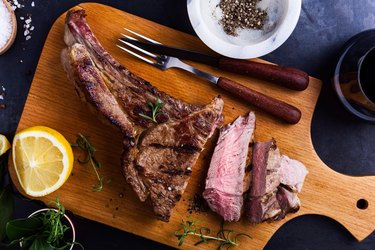
Medium-rare ribeye steak is a flavorful, tender cut of beef you can prepare using several methods, including broiling, grilling or pan-frying. Pair this juicy steak with a side of our Thanksgiving Garlic Smashed Potatoes and Steamed Broccoli Florets for a delicious weeknight meal.
Cooking a Medium-Rare Ribeye
Video of the Day
Kirk Biondi, corporate chef and manager of culinary training at Ted's Montana Grill, tells LIVESTRONG.com about two methods for cooking a medium-rare ribeye.
Video of the Day
Cast-Iron Method
The cast-iron method on the stove is Biondi's preferred method. Here are his steps for a pan-fried ribeye steak with butter. For extra flavor, you can add fresh herbs, thyme or rosemary.
- Remove the ribeye steak from packaging at least 30 minutes before cooking.
- Place on a cast-iron or sauté pan over medium-high heat with 1.5 ounces of oil. Once the oil is almost at smoke point, add the ribeye to the pan.
- For a 1- to 1.5-inch-thick ribeye, flip after four to five minutes.
- Add 1 ounce of butter or seasoned compound butter. Using a spoon, baste the ribeye with the melted butter.
- Cook for another four to five minutes.
- Once the steak reaches 130 to 135 F, remove from the pan.
- Let the meat rest for five minutes before slicing.
For a more thoroughly cooked steak without any rare meat, cook until it reaches a minimum of 145 F.
Grill Method
- Remove the ribeye steak from packaging at least 30 minutes before cooking.
- Heat the grill to 425 to 450 F.
- Rub both sides of the steak with salt and pepper and 1 ounce of olive oil.
- Place the ribeye on the heated grill and cook for four to five minutes.
- Flip your ribeye steak and season again.
- Cook for four to five minutes.
- Once the steak reaches 130 to 135 F, remove from the grill.
- Let the meat rest for five minutes before slicing.
For a more thoroughly cooked steak without any rare meat, cook until it reaches a minimum of 145 F.
Temperature of Medium-Rare Ribeye
Cooking a rare ribeye steak requires serving the meat at a temperature lower than the recommended safety guidelines from the USDA Food Safety and Inspection Service (USDA FSIS). This raises questions about the difference between doneness versus food safety.
According to the USDA FSIS, the safe internal temperature of a steak should reach 145 degrees F, as measured by a food thermometer, before it is safe to serve. Yet some medium-rare ribeye steak is typically served lower than 145 F, which comes close to the USDA FSIS's safe minimum temperature.
But a rare ribeye steak is often served as low as 125 F, which the Academy of Nutrition and Dietetics does not recommend since there is no way to guarantee the safety of rare meat when you go with an internal temperature this low.
When ordering a medium rare or rare steak at a restaurant, make sure and ask about the minimum internal temperature. The server should be able to tell you what the chef uses as a guide to doneness.
Food Safety and Foodborne Illness
The USDA FSIS explains that doneness is determined by appearance, texture and optimum flavor of a food, but this doesn't always mean the food is cooked to the minimum safe temperature recommended by food safety experts. Therefore, if you want to avoid any potential foodborne illnesses, cooking ribeye steak to a minimum of 145 F is the best option.
According to the Centers for Disease Control and Prevention (CDC), anyone can get a foodborne illness. Some of the more common symptoms include vomiting, stomach cramps, diarrhea and nausea. While these symptoms generally go away on their own, some people may experience more severe symptoms that require immediate attention.
Pregnant women, people with a compromised immune system, older adults and young children are all at a greater risk of developing a foodborne illness. If you fall into any one of these groups, take extra care to ensure your food is cooked thoroughly and that you follow all safety guidelines for storing and reheating food as set by the CDC.